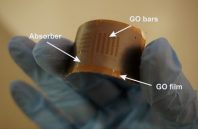Researchers at Swinburne University of Technology (Hawthorn, VIC, Australia), the University of Sydney (Sydney, NSW, Australia), and Australian National University (Canberra, ACT, Australia) have collaborated to develop a solar absorbing, ultrathin graphene-based film with unique properties that has great potential for use in solar thermal energy harvesting. The work is published in Nature Photonics.
The 90 nm thick material can rapidly heat up to 160 °C under natural sunlight in an open environment, creating a pathway towards new thermophotovoltaics (the direct conversion of heat to electricity), solar seawater desalination systems, infrared light sources and heaters, modulators and interconnects for communication devices, photodetectors, color displays, and even ‘invisible cloaking technology’ through developing large-scale thin films enclosing the objects to be hidden.
The 2.5 cm x 5 cm working prototype demonstrates the photothermal performance of the graphene-based metamaterial absorber and the researchers have also proposed a scalable manufacture strategy to fabricate the proposed graphene-based absorber at low cost.

 (585) 768-2513
(585) 768-2513

